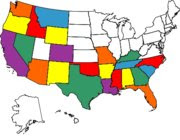Weather: low 65 degrees, high 78 degrees, mostly clear skies
Remember in yesterday's post that I started wiping the RV down, and I mentioned that rain should follow soon? Well, rain came last night, starting about 2200 hours and lasting most of the night. Now, where can I find a good marketer for my rain making services?
 I have been planning to visit the Alabama Museum of Natural History for some time, and today seemed like a good day to do that. The museum is located in Smith Hall on the University of Alabama campus. It has been operating for about 100 years and the collections had to be rebuilt after the Civil War when Federal soldiers destroyed most of the exhibits. When I entered the museum, a lady at the counter took my money ($1.00) and explained what was located on each of the three floors. The first floor has environmental exhibits and stresses recycling. There are also exhibits on what would happen if certain activities were curtailed, such as cutting out at least one 20 mile trip a week. They lost me a little when I saw all the posters and what I would call propaganda about the damage being caused by the widespread use of carbon based fuels.
I have been planning to visit the Alabama Museum of Natural History for some time, and today seemed like a good day to do that. The museum is located in Smith Hall on the University of Alabama campus. It has been operating for about 100 years and the collections had to be rebuilt after the Civil War when Federal soldiers destroyed most of the exhibits. When I entered the museum, a lady at the counter took my money ($1.00) and explained what was located on each of the three floors. The first floor has environmental exhibits and stresses recycling. There are also exhibits on what would happen if certain activities were curtailed, such as cutting out at least one 20 mile trip a week. They lost me a little when I saw all the posters and what I would call propaganda about the damage being caused by the widespread use of carbon based fuels.  There were three items that intrigued me the most. The first was the picture above, which is the State Fossil of Alabama. The exhibit is the fossilized remains of a whale, Basilosaurus cetoide, that lived in shallow coastal waters about 37 million years ago. Originally, the whale was misnamed, because Basilosaurus indicates that the remains were of a giant lizard. Once it was known that the remains were of a whale, the name still had to be kept because the rules regarding animals states that the first name given to an animal must be kept. The second exhibit I enjoyed was of a woolly mastodon skull, found in the Tombigbee River near Demopolis. I wonder how difficult it was for them to eat with tusks as long and curved as these were?
There were three items that intrigued me the most. The first was the picture above, which is the State Fossil of Alabama. The exhibit is the fossilized remains of a whale, Basilosaurus cetoide, that lived in shallow coastal waters about 37 million years ago. Originally, the whale was misnamed, because Basilosaurus indicates that the remains were of a giant lizard. Once it was known that the remains were of a whale, the name still had to be kept because the rules regarding animals states that the first name given to an animal must be kept. The second exhibit I enjoyed was of a woolly mastodon skull, found in the Tombigbee River near Demopolis. I wonder how difficult it was for them to eat with tusks as long and curved as these were? The third exhibit I liked was the Hodges Meteorite, an eight pound meteorite that is listed as the only documented event where a person was hit by a falling meteorite. This occurred in November of 1954 near Sylacauga, Alabama. The woman struck by the meteorite did not suffer any serious injuries, probably because it came down through the roof before it struck her. Can you imagine the shock and chaos that erupted when this happened? This is the kind of quirky stuff that I love to find. The tour of the museum was worthwhile, but I was disappointed that a museum owned by the state and located on the campus of a major university did not have any more exhibits than this one had.
The third exhibit I liked was the Hodges Meteorite, an eight pound meteorite that is listed as the only documented event where a person was hit by a falling meteorite. This occurred in November of 1954 near Sylacauga, Alabama. The woman struck by the meteorite did not suffer any serious injuries, probably because it came down through the roof before it struck her. Can you imagine the shock and chaos that erupted when this happened? This is the kind of quirky stuff that I love to find. The tour of the museum was worthwhile, but I was disappointed that a museum owned by the state and located on the campus of a major university did not have any more exhibits than this one had.Tomorrow I'll talk about another find I made on the campus that helped change the course of history of our country.
More later, be safe.
Today's Town - Mobile, Alabama: The Port City
Not all who wander are lost.




No comments:
Post a Comment